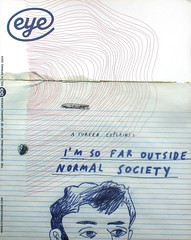Spring 2005
Isometric illustrator
Manual: A book about hands
by George Hardie<br>Exhibition: 13 Dec 2004–21 Jan 2005, Pentagram Gallery, LondonHipgnosis. Dark Side of the Moon. Hardie’s iconic collaborations with Storm Thorgerson and co. for Pink Floyd, Black Sabbath, Genesis and other more obscure bands from the 1970s were for many of us image makers, then still at school and not sure what design was, our first introduction to the power and allure of the image – the graphic object as a totemic icon, imbued with latent meaning.
Although our pocket money wouldn’t stretch to a £3.99 vinyl LP, we could browse the racks of W. H. Smith and imagine what the music behind those evocative covers might sound like. I vividly recall the inner sleeve of Wings’ Venus and Mars, a series of diagrammatic snooker-ball collisions in yellow and red, but to this day have never heard the album. For many designers this experience will be familiar, and maybe this is for the best – like reading a single isolated instalment of a narrative, we were free to invent the before and after.
The exhibition focuses on work that is to be published as a book, Manual, which will available in a limited edition of 99 copies. Described by Hardie as a process of ‘going amateur’, this is more a book of ‘graphics without clients’ than an artist’s book and contains some 90 images and inserts, many with handmade elements: tipped-in silksreens, found objects, sign language charts and roadkill glove images. Taking the theme of all things hand-related, they display Hardie’s fascination with the printing process, using a limited colour palette, type / image counterpoint, the recontexturalised informational chart or sign, the found woodcut image and the verbal and typographic pun.
These are often executed in the familiar isometric ligne claire style, part Patrick Caulfield, part Ever Meulen, part Joost Swarte architectural grid, coloured in the muted eau de nil greens, pinks and heliotropes of faded sugarpaper-covered schoolbooks, with that most English of typefaces, Gill Sans, used almost exclusively.
Relating a narrative is part of Hardie’s fascination with the image – a narrative often delivered in a single frame, of some event that has passed As with Trechikoff’s The Party, the participants (rarely seen in Hardie illustrations) have exited stage left, leaving the observer to piece together the whole picture.
George Hardie is an example of that rare breed: an illustrator with an exquisite sense of type and design, and a designer who can actually draw.
First published in Eye no. 55 vol. 14 2005
Eye is the world’s most beautiful and collectable graphic design journal, published quarterly for professional designers, students and anyone interested in critical, informed writing about graphic design and visual culture. It is available from all good design bookshops and online at the Eye shop, where you can buy subscriptions, back issues and single copies of the latest issue. You can also browse visual samples of recent issues at Eye before You Buy.

